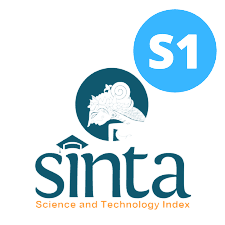Performance of Doped Montmorillonite on Photosensitizer Based Natural Dyes Gardenia Jasminoides
Abstract
Dye Sensitized Solar Cell (DSSC) is an electrochemical cell that is able to convert solar energy from light to electrical energy. This technology is needed by the world as a renewable and environment friendly energy. In this study, we evaluate the consideration of modification montmorillonite and Gardenia jasminoides dyes may achieve better performance of DSSC by manufactured DSSC with modified TiO2 semiconductors using montmorillonite (MMT) and Nafion. Performance of DSSC was determined by potentiometer. Atomic force microscope was used to evaluate the characteristic of DSSC. The UV-vis results revealed that the dyes which is extracted from the Gardenia jasminoides content crocin and quercetin compounds. Modification DSSC contains ratio of MMT: nafion (50:50) exhibited highest power conversion efficiency value of 0.8316%. Topography of surface ensured the dyes have occupied surface area and able to promote electron to higher energy. However, MMT and nafion capable to enhance potential of dyes as photosensitizer in DSSC.
Keywords
Full Text:
PDFReferences
1 Darmokoesoemo, H., Setyawati, H., Ningtyas, A. T. A., and Kusuma, H. S. 2017. The Study Of Effect Of Metal Ion Fe (III) On The Chlorophyll As Potential Photosensitizer On Dye Sensitized Solar Cell. Rasayan Journal Chemistry, 2, 10.
2 Gratzel, M. 2003. Dye-sensitized Solar Cells. Journal of Photochemistry and Photobiology, 4(9), 145-153.
3 Gong, J., Sumathy, K., Qiao, Q., Zhou, Z. 2017. Review on Dye-sensitized Solar Cells (DSSCs): Advanced Techniques and Research Trends. Renewable and Sustainable Energy Reviews, 68(12), 234-246.
4 Wongcharee, K., Meeyoo, V., Chavadej, S. 2007. Dye-Sensitized Solar Cell Using Natural Dyes Extracted From Rosella and Blue Pea Flowers. Solar Energy Material & Solar Cells, 91(5), 566-571.
5 Dahlan, D., Saad, S. K. Md., Berli, A. U., Bajili, A., Umar, A. A. 2017. Synthesis of Two-Dimensional Nanowall of Cu-Doped TiO2 and Its Application as Photoanode in DSSCs. Physica E (Low-dimensional System and Nanostructures), 19(5), 185-189.
6 Shalini, S., Prabavathy, N., Balasundaraprabhu, R., Kumar, T. S., Velauthapillai, D., Balraju, P., Prasanna, S. 2017. Studies on DSSC Encompassing Flower Shaped Assembly of Na-doped TiO2 Nanorods Sensitized with Extract from Petals of Kigelia Africana. International Journal for Light and Electron Optics, 155, 334-343.
7 Suryadi, J., Gunawan., Haris, A. 2010. Pembuatan dan Penentuan Nilai Efisiensi Sel Surya Berpewarna Teesensitisasi dengan Senyawa Antosianin dari Buah Manggis (Garcinia mangostana L.) sebagai Pewarna Pensensitisasi. Jurnal Kimia Sains dan Aplikasi, 13(3), 88-94.
8 Nafi, M., dan Susanti, D. 2013. Aplikasi Semikonduktor TiO2 dengan Variasi Temperatur dan Waktu Tahan Kalsinasi sebagai Dye Sensitized Solar Cell (DSSC) dengan Dye dari Ekstrak Buah Terong Belanda (Solanum betaceum). Jurnal Teknik Pomits, 1(2), 2337-3539.
9 Kakiage, K., Aoyama, Y., Yano, T., Oya, K., Fujisawa, J., Hanaya, M. 2015. Highly-Efficient Dye-Sensitized Solar Cells with Collaborative Sensitization by Silyl-Anchor and Carboxy-Anchor Dyes. Chemical Communications, 88, 15869–16002.
10 Venkatesan, S., dan Lee, Y. L. 2017. Nanofillers in The Electrolytes of Dye-Sensitized Solar Cell-A Short Review. Coordination Chemistry Reviews, 353(55), 58-112.
11 Alonso, R. F., Estevez, L., Lian, H., Kelarakis, A., Giannelis, E. P. 2009. Nafion-Clay Nanocomposite Membranes: Morphology and Properties. Polymer, 50(9), 2402-2410.
12 Paik, Y. S., Lee, C. M., Cho, M. H., Hahn, T. R. 2001. Physical Stability of the Blue Pigments Formed from Geniposide of Gardenia Fruits: Effects of pH, Temperature, and Light. Journal of Food Chemistry, 49(3): 430-432.
13 Syafinar, R., Gomesh, N., Irwanto, N., Fareq, M., Irwan, Y. M. 2015. Chlorophyll Pigments as Nature Based Dye for Dye-Sensitized Solar Cell (DSSC). Energy Procedia, 79(7): 896-902.
14 Sennour, R., Mimane, G., Benghalem, A., Taleb, S. 2009. Removal og The Persistent Pollutant Cholobenzene by Adsorption Onto Activated Montmorillonite. Applied Clay Science, 43(4): 503-506.
15 Debnath, P., Park, N. C. D., Nath, N. B., Samad, H. W., Park and Lim, B.O. 2011. In vitro antioxidant and anti-inflammatory activities of Korean blueberry (Vaccinium corymbosum L.) extracts. Food Chemistry, 128, 7.
16 He, M., Cheng, X., Chen, J., and Zhou, T. 2006. Simultaneous Determination of Five Major Biologically Active Ingredients in Different Parts of Gardenia jasminoides Fruits by HPLC with Diode-Array Detection. Chomatographia, 64(5), 713-717.
17 Tungjai, M., Poompimon, W., Loetchutinat, C., Kothan, S., Dechsupa, N., Mankthetkorn, S. 2008. Spectrophotometric Characterization of Behavior and The Predominant Species of Flavonoids in Physiological Buffer: Determination of Solubility, Lipophilicity and Anticancer Efficacy. The Open Drug Delivery Journal, 2(10), 10-19.
18 Yin, F., Liu, J. 2018. Research and Application Progress of Gardenia jasminoides. Chinese Herbal Medicines, 10 (4), 362-370.
19 Ye, M., Wen, X., Wang, M., Iocozzia, Zhang, N., Lin, C., Lin, Z. 2015. Recent Advances in Dye-Sensitized Solar Cells: from Photoanodes, Sensitizer and Electrolytes to Counter Electrodes. Materials Today, 3(18).
20 Jurado, C. B., dan Valdes, E. A. 2009. Bronsted Sites on Acid-Treated Monmorilonit: A Theoretical Study with Probe Molecules. Journal of Physics Chemistry, 113(8), 8994-9001.
21 Adedokun, O., Titilope, K., Awodugba, A. O. 2016. Review on Natural Dye-Sensitized Solar Cells (DSSCs). International Journal of Engineering Technologies, 2(2), 34-41.
22 Sulaeman, U., Abdullah, A. Z. 2017. The Way Forward for The Modification od Dye-sensitized Solar Cell Toward Better Power Conversion Efficiency. Renewable and Sustainable Energy Reviews, 74(15), 438-452.
23 Ghann, W., Kang, H., Sheikh, T., Yadav, S., Chavez-Gil, T., Nesbitt, F., Uddin, J. 2016. Fabrication, Optimization and Characterization of Natural Dye Sensitized Solar Cell. Scientific Reports, 7, 41470.
Refbacks
- There are currently no refbacks.
















